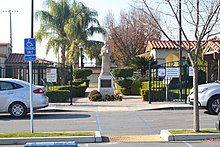Francisco Garcés
Francisco Garcés Franciscan friar, priest and explorer |
|---|
Francisco Hermenegildo Tomás Garcés
History
Garcés was born April 12, 1738, in
New Spain

Garcés travelled to New Spain (
Missionary
The expulsion of the Jesuits by the Spanish King set in motion a sequence of dramatic events in the missions. The Franciscans from the college of Santa Cruz in Querétaro took over responsibility in the Sonoran Desert missions region in the present-day Mexican state of Sonora and the U.S. state of Arizona. Meanwhile, other Franciscans from the college of San Fernando in Mexico City under the leadership of Junípero Serra, were assigned to replace the Jesuits in the Baja California missions of the lower Las Californias Province.
Explorer

Garcés became a key player in this effort, conducting extensive explorations in the Sonoran, Colorado, and
Death
In 1779–81 Garcés and
Garcés' body was later reinterred at Mission San Pedro y San Pablo del Tubutama. He and the other friars killed at those missions are considered martyrs by the Catholic Church.[3]
Legacy

- El Garces Hotel
The
- National Forest
Garces National Forest was established by the U.S. Forest Service in southern Arizona on July 1, 1908, with 78,480 acres (317.6 km2) from portions of Baboquivari, Tumacacori and Huachuca National Forests. The name was discontinued in 1911 when it was combined with Coronado National Forest.
- Bakersfield
The first
- Las Vegas, Nevada
The original platted east–west streets of the 1905 Las Vegas Township are all named for significant North American explorers, beginning with Stewart on the north, then Ogden, Fremont, Carson, Bridger, Lewis, Clark, Bonneville, Gass, and finally Garces on the south.
- Reno, Nevada
St. Thomas Aquinas Cathedral has a stained glass window dedicated to Fray Garces.
See also
- Spanish missions in the Sonoran Desert
- Spanish missions in Baja California
- California Historical Landmarks in Kern County
- California Historical Landmark
- Canyon of the Little Christians
Notes
- ^ American Catholic.org Archived 2012-05-21 at the Wayback Machine
- ^ a b c d e f g mojavedesert.net: Garcés . accessed 1.1.2012
- ^ Garcés 1900, p. xxiv.
References
- Garcés, Francisco. 1900. On the Trail of a Spanish Pioneer: The Diary and Itinerary of Francisco Garcés. Edited by Elliott Coues. Two vols. Francis P. Harper, New York, NY.
- Garcés, Francisco. 1967. A Record of Travels in Arizona and California, 1775–1776. Edited by John Galvin. John Howell, San Francisco.
External links
- Web de Anza: 1774 Diary of Padre Francisco Garcés — Discovery Expedition: during January - July 1774.
- Web de Anza: 1776 Diary of Padre Francisco Garcés — Colonizing Expedition: during October - December 1776.
- MojaveDesert.net: Francisco Garcés - "Missionary priest who led an expedition across the Mojave" - history webpage
